Inside Swiss-US energy talks
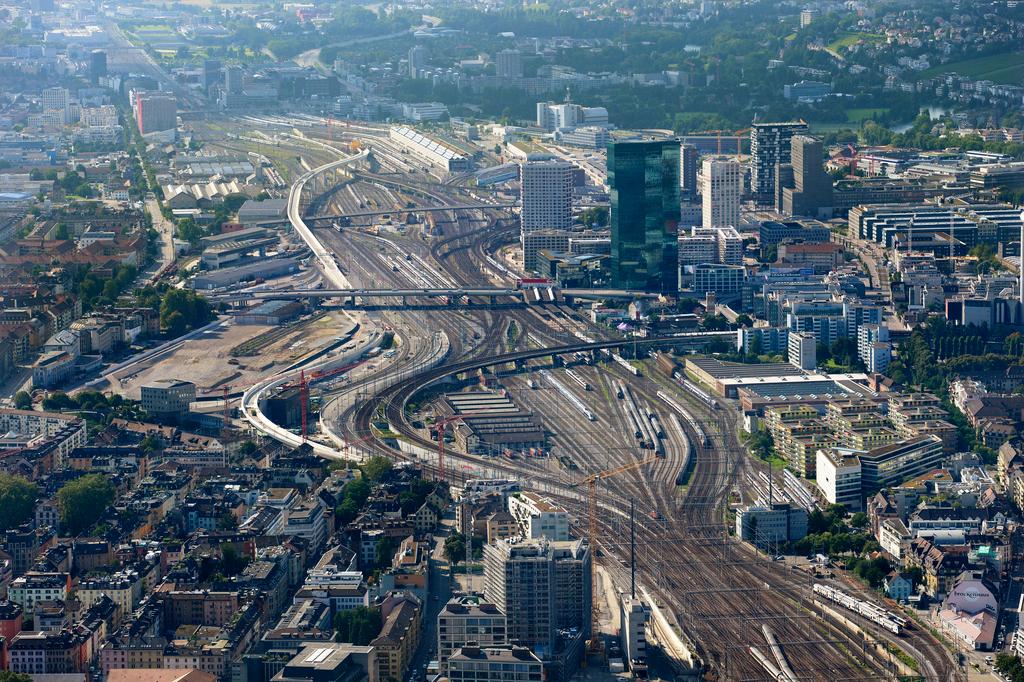
Can you imagine a town named Oxygen? It's one of the site visits for the Swiss-US Energy Innovation Days 2015External link, taking place this week from August 19-21. We are live-blogging workshops, talks, and up-close-and-personal site visits to some of the world's most advanced innovations in smart energy technologies and sustainable energy systems.
–>August 20, 19:30 – Day 2
This is the final evening of live-blogging the Swiss-US Energy Innovation Days. Tomorrow morning, there will be a closing session in the Toni-Areal building, where a mini-exhibition of this year’s Watt D’OrExternal link winners will be on display. In addition to talks from Swiss Federal Office of Energy Director Walter Steinmann, MassCEC Director Alicia Barton, Google Switzerland Director Patrick Warnking, ETH Zurich President Lino Guzzella, and Swissnex Boston Consul Felix Moesner, the chairs of all the workshops will present a panel discussion.
At the end of the session, US Ambassador to Switzerland Suzan Levine will present conclusions of the Swiss-US Energy Innovation Days from a US perspective, while Swiss Energy Minister Doris Leuthard will present her views.
As for today, we ended with a poster session and reception at the IBM facility in Rüschlikon. At the reception, I caught up with three attendees – two from the United States and one from Switzerland – who looked back at the events of the last two days.
LIVE on #PeriscopeExternal link: Swiss-US Energy Innovation Days – attendee impressions https://t.co/BtoMVyrsnOExternal link
— swissinfo.ch (@swissinfo_en) August 20, 2015External linkFrom left to right: Benjamin Franta, PhD candidate in Applied Physics, Harvard UniversityExternal link, Cambridge, MA, USA; Clemens Bolli, Board Member, WasserwirbelExternal link, Aarau, Switzerland; Emily Reichert, CEO, Greentown LabsExternal link in Somerville, MA, USA.
Though small, the sample reflects the tremendous diversity of attendees at the Swiss-US Energy Innovation Days, from start-ups to large businesses to government and academia. It’s been a privilege to hear about energy research from those who are at the very forefront, and I hope to be able to catch up with the next programme, regardless of geographical location.
–>August 20, 18:00 – Day 2
The “self” building at the Swiss Federal Laboratories for Materials Science and Technology (EMPA) in Dübendorf is a dwelling that resembles the Solar Impulse plane: it requires no fossil fuel.
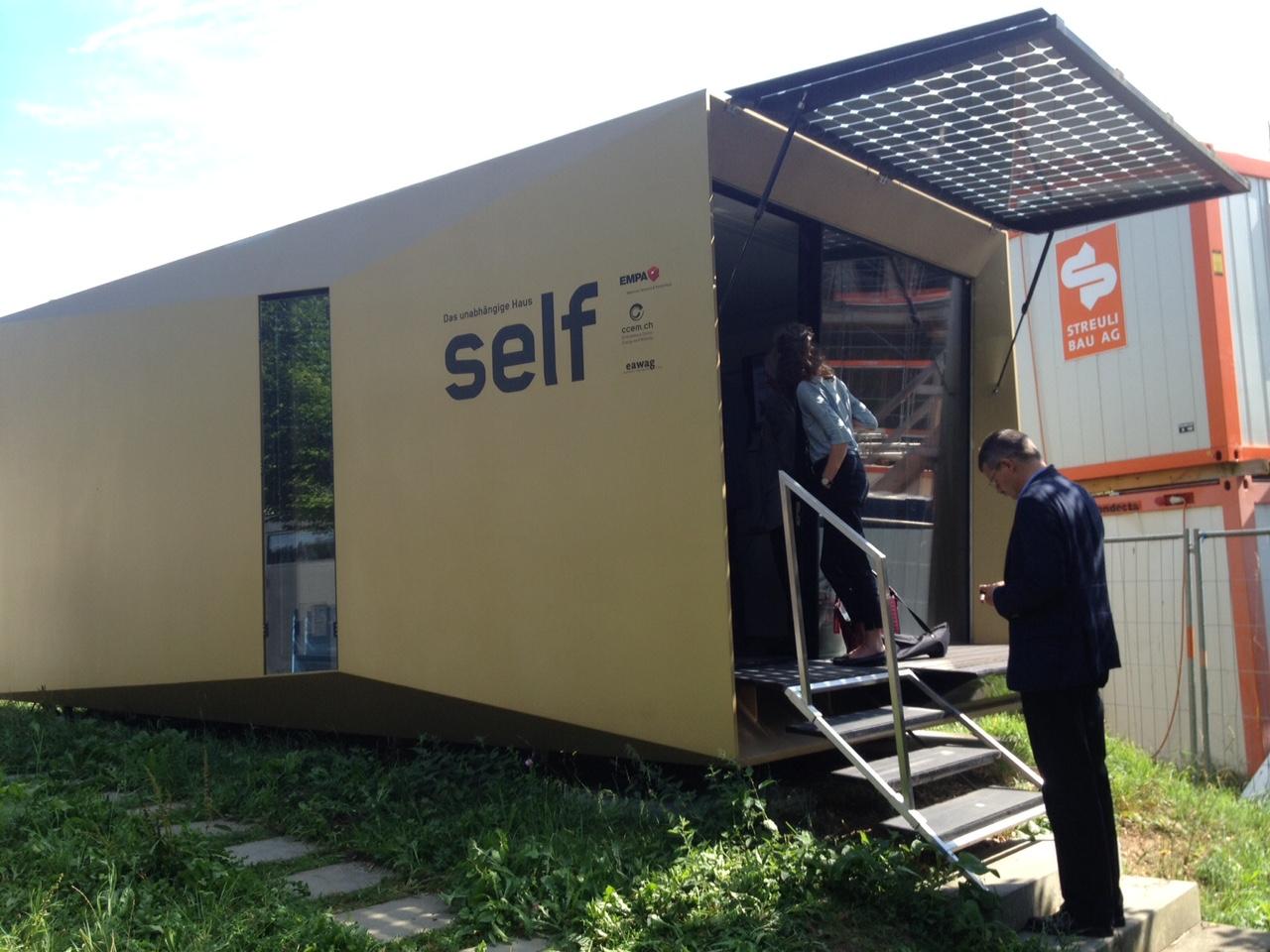
It is a self-contained research unit that is exceptionally well-insulated, solar heated, and it passively collects and filters rainwater for use in washing and toilets.
–>August 20, 16:00 – Day 2
Seeing the light
Researchers at EMPA are also developing better photovoltaic technologies for converting sunlight into electricity.

These thin films are about 0.5 to 1 micron thick -100 times thinner than traditional silicone wafers used in solar panels – but they are still high efficiency.
They are laid out onto foils so thin, they can actually be rolled up.
–>August 20, 15:35 – Day 2
Under construction
Upon arriving at the Swiss Federal Laboratories for Materials Science and Technology (EMPA) in Dübendorf, we catch a glimpse of what looks like an ordinary construction site.
In fact, the multi-story structure covered in scaffolding is the foundation of what will become EMPAExternal link‘s (link in German) NEST project. NEST stands for Next Evolution in Sustainable Building Technologies, and it is an apt acronym: NEST is an incubator for innovations in architecture and construction that conserve both water and energy, and limit production of greenhouse gases.
When finished, NEST will have modular, interchangeable research units designed for the study of innovation in building materials and energy management.
But NEST won’t just be a model – the different spaces within the building will be used by guests, researchers and employees of EMPA and other Swiss government programmes.

The constant, real-world activity inside the building should allow EMPA researchers to collect real data on the building’s energy and resource use. The backbone of the NEST building should be done by the end of this year, after which the first research modules will be installed.
–>August 20, 12:00 – Day 2
Taking a green leaf out of San Francisco’s book
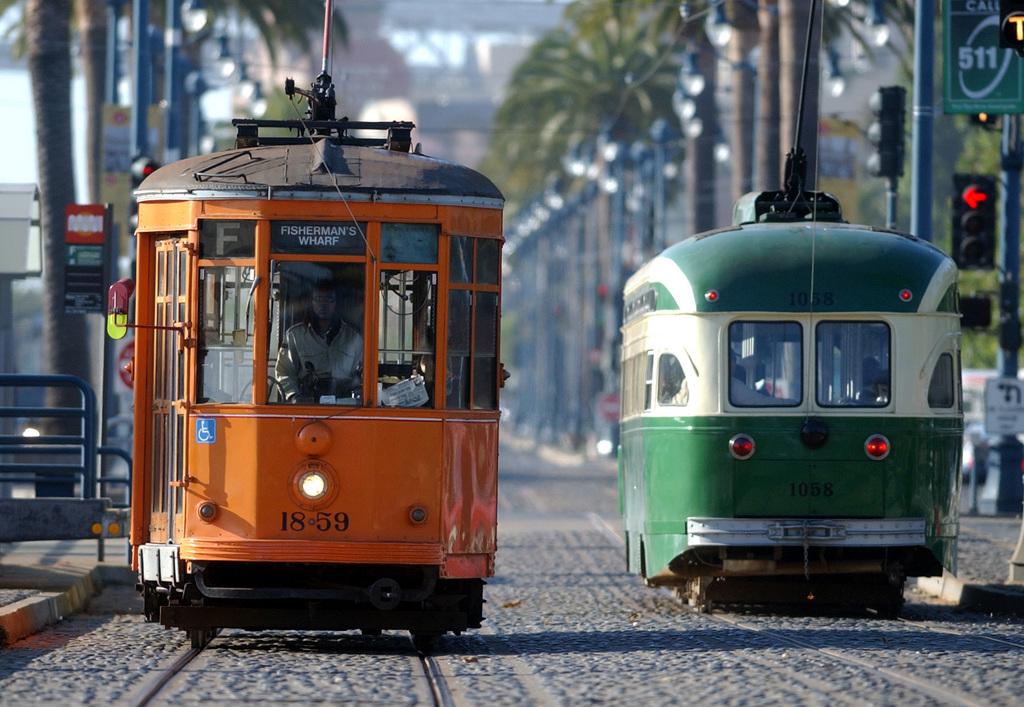
In 2015, the San Francisco Transportation Agency reached its goal of relying 50% of the time on private cars and 50% of the time on other forms of transportation, including bikes, public transport and car sharing. In 2004, on the city’s busy Market Street, there were three cars for every bike. By 2014 that figure had reversed: there were three bikes for every car! How did they turn it around?
The goal was to prioritise ‘people spaces’
Timothy Papandreaou, director of the San Francisco Transportation Agency, brought some perspectives on urban energy efficiency in an American city.
A major element of the transformation of San Francisco’s streets was infrastructure support. Pavements were widened significantly for foot traffic, and clearly marked bike lanes were put in place. The goal was to prioritise “people spaces” – travel corridors for individuals that are safe and easy to navigate.
Increasing the convenience and attractiveness of ride and car-sharing was another major element in San Francisco’s success. These efforts and the phone apps to access them have been growing in recent years, but they must compete for space and infrastructure with private automobile traffic.
Part of the city’s strategy was to prioritise car sharing spaces, of which the city now has more than 1,000. A post from the San Francisco Street blogExternal link shows that more than half of trips in San Francisco are made without a private car.
–>August 20, 10:30 – Day 2
Mobility in an ideal world
The second day of the Swiss-US Energy Innovation days starts back at the Toni-Areal building, with clearing skies overhead. Yesterday’s schedule was packed from start to finish, but the group seems no less eager to get to business this morning.
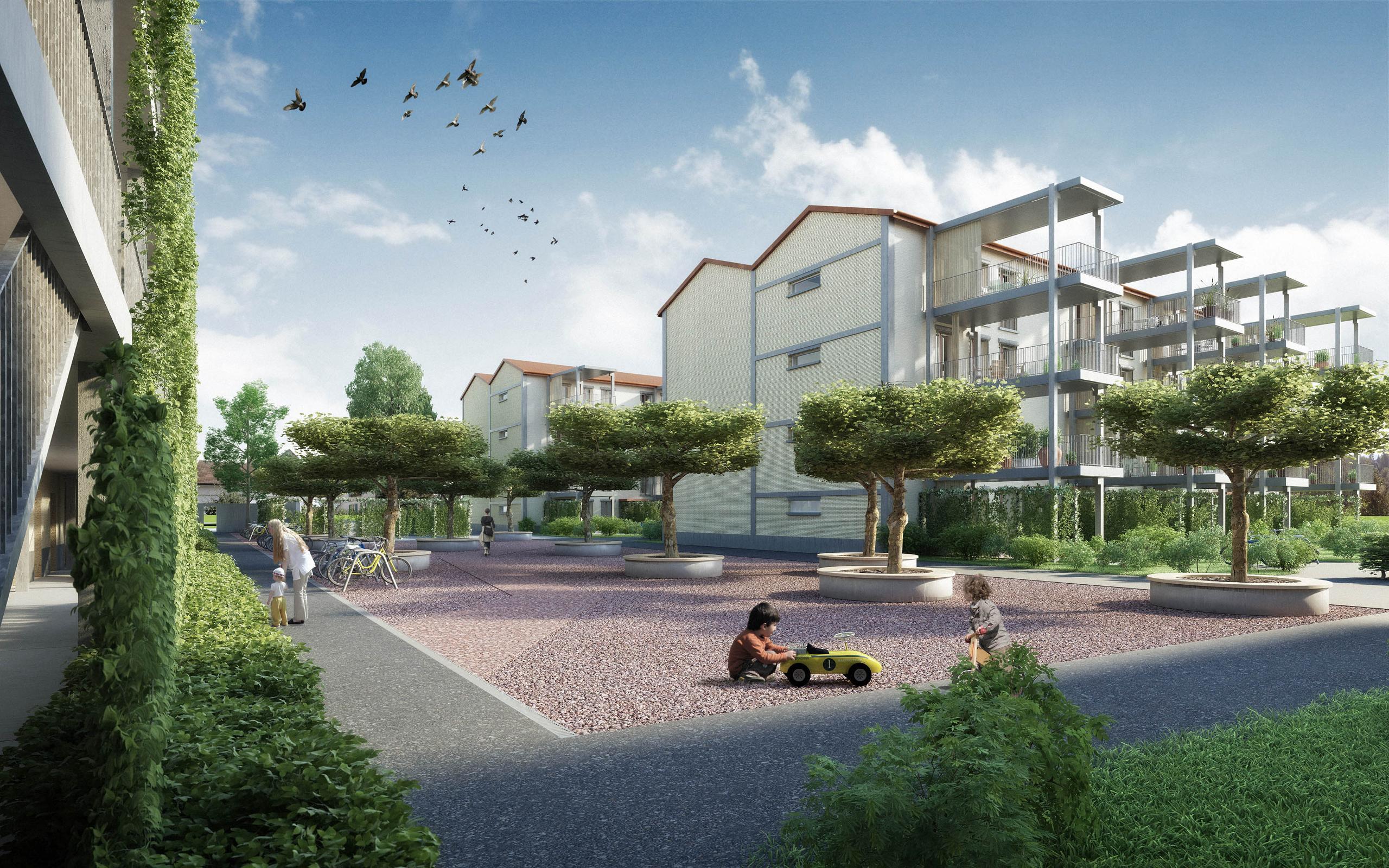
In today’s mobility workshop, we start off with a talk from Stephan Lienin from SustainservExternal link, a sustainability consulting firm based in both Zurich and Boston. Lienin told us about a two-year project that he led, on the future of urban mobility in Zurich.
Changing times, changing preferences
25% of young Swiss adults do not have a driver’s license – this says something about Switzerland’s mass transit/public transport infrastructure! And for some people the car has lost much of its significance as a wealth status symbol in recent years.
Meanwhile, the development of more energy efficient transportation technologies, such as autonomous vehicles and electric cars may encourage urban sprawl, with people living further apart from each other. Participants at the innovation talks expressed concern that such developments may effectively cancel out other environmentally-friendly advances.
The goal of the project was to bring together 50 organisations at regular intervals over two years to answer a single question: What should urban mobility look like in Zurich by the year 2035? The participants came up with many ideas, as communicated in the project reportExternal link (German only), but the main features of an ideal future Zurich included:
- Shorter travel distances, thanks to sustainable spatial and residential area plans
- Transparent mobility costs
- Less commuter traffic, due to more flexible forms of work
- Efficient mobility, thanks to networked services and mobility management
- Safer and more efficient transport, thanks to cutting-edge technology
Based on their results, several pilot projects were launched, including a flexible work schedule programme at Credit Suisse to reduce commute times, and an alternative, app-based form of electric car sharing called eMOTIONExternal link (German/French).
One of Lienin’s major points was that mobility innovations and technologies are important, but that they cannot be effective unless they are closely linked to resource efficiency, social acceptance, and affordability.
He noted that an important element of future innovations in mobility will be “urban labs” – public-private partnerships designed to field test new technologies in cities.
–>August 19, 17:40 – Day 1
Saving energy for tomorrow…
Stay tuned for more Energy Innovation updates tomorrow. The morning will see the four workshop tracks take participants into a series of fresh topics, with visits to laboratories at EMPA Dübendorf and IBM Rüschlikon in the afternoon.
It’s been a long day, but the rain has stopped and we are a bus full of buzzing conversationalists as we make our way back to Zurich. Many of the things we’ve seen and heard today are brand new to us, but maybe, before long, they will seem commonplace.
–>August 19, 16:50 – Day 1
Breathe in, breathe out
Suurstoffi means oxygen in Swiss German – a fitting name for a CO2-free urban district with no trafficExternal link.
The Zug Estates Group is in the process of constructing this ten-hectare, 1,500-resident community. There are already 382 rental apartments available, 19,000 square metres of commercial space, a daycare centre, a school and a gym. Already, Suurstoffi can boast 700 residents and 400 workers.
The mechanical and electric equipment is solar-powered, and the municipality’s buildings use “anergy”, a process wherein waste heat is stored underground and re-released when it is needed. This process is estimated to be 20-30% more efficient than traditional systems thanks to its use of surplus energy – no fossil fuel required.
With its photovoltaic electricity system, Suurstoffi has a capacity of 400,000 kwh, the largest private system of its kind in the region. Production is expected to reach 960,000 kwh by the end of the year.
The data produced by this experimental city are monitored by the nearby Lucerne University of Applied Sciences and arts.
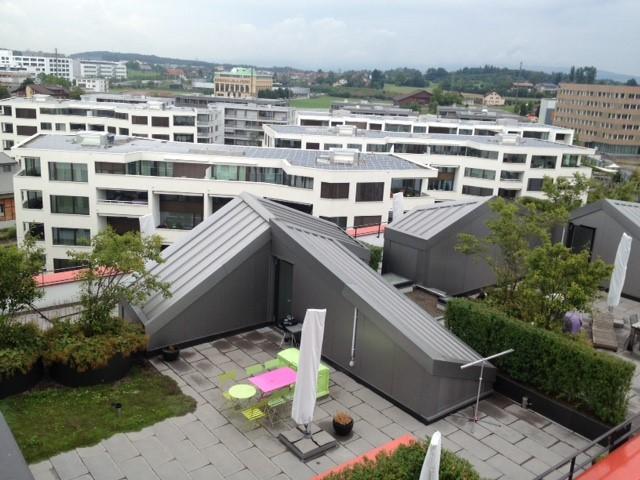
–>August 19, 15:30 – Day 1
How smart is your house?
The first site visit is to a project – at least part of it – called yourExternal link+ that was created by students of the Lucerne University of Applied Sciences and Arts. The project won the 2015 Swiss Watt d’Or award for best energy project in the education category. A larger version of this energy efficient building was a winner at the Solar Decathlon competition to design solar-powered homes in Paris in 2014.
At @hsluExternal link – portion of a Solar Decathlon entry – an energy efficient, shared living space prototype! pic.twitter.com/OUR9nGSnoxExternal link
— Celia Luterbacher (@scienceceals) August 19, 2015External linkIt is designed to be a shared space, and to function as a ‘smart’ building: one that can sense energy use, use weather forecasts to plan energy use in advance, and share energy with neighbours when its own needs are exceeded.
–>August 19, 11:30 – Day 1
The best of both worlds
It is a rainy morning in Zurich, but the atmosphere is bright and energetic inside the Toni-Areal building of the Zurich University of Applied Sciences (ZHAW). Already, 130 experts in energy, architecture, policy and academia have gathered – some from Switzerland and some from the United States – twice the number of anticipated participants for the morning’s workshops. But with typical Swiss aplomb, there are somehow still enough coffee and croissants to go around.
This is the second Swiss-US Energy Innovation DaysExternal link; the first was held last year in Boston, and was so successful that it looks like it may become an annual event. We are welcomed by Daniel Seelhofer of the university’s School of Management and Law. He welcomes the “most brilliant minds” from both the US and Switzerland to Zurich, telling the audience that the building we are sitting in was once was once a dairy factory, and that Albert Einstein once taught at the university.
The four parallel workshops this morning are on Society and Economy, Energy Technologies, Mobility, and Architecture and Space – site visits will follow after lunch. The Mobility session kicks off with a presentation from Adrian Burri of ZHAW’s school of engineering. His project is the BICARExternal link – a bicycle-car combo straight out of a futuristic comic book.
The BICAR is presented as an example of what can happen when innovation is done with equal attention to user behaviour, technology, business models and sustainability: it is a 70kg, honeybee-yellow vehicle designed for city transport, combining the energy efficiency and nimbleness of a bike with the comfort and safety of a car. Burri calls it “the best of both worlds.” Unveiled in May 2015, Burri says that eight BICARS can park in a traditional car parking space. Designed for one person at a time – it is intended to be shared so that it is in use more than 95% of the time.
In the Society and Economy session, the discussion is more theoretical, but equally charged. One of my favourite quotes of the day so far is delivered by Robert KruegerExternal link of the Worcester Polytechnic Institute in Massachusetts. “A low carbon future is not a sector of the economy – it is the economy.” He argued that in transitioning to such an economy, we are limited by our outdated measures of success – like GDP, for example. “We are looking to create a new economy, but we are evaluating it based on knowledge of old economy…and that is problematic,” he said.
Swiss-US Energy Innovation Days
Around 300 experts in energy, policy and business from the States and Switzerland are gathering at the Zurich University of Applied Sciences for the Swiss-US Energy Innovation Days 2015, the theme of which is Integrated Building Systems. The event is intended to bring together some of the brightest minds of both nations to address, in a highly practical way, one of today’s most pressing problems: how to power society in a way that is sustainable both environmentally and economically. The event is organised by the Swiss Federal Office of Energy, the Massachusetts Clean Energy Center, the Swiss Society of Engineers and Architects, Switzerland Global Enterprise (S-GE), the Zurich University of Applied Sciences and swissnex Boston.

In compliance with the JTI standards
More: SWI swissinfo.ch certified by the Journalism Trust Initiative









You can find an overview of ongoing debates with our journalists here . Please join us!
If you want to start a conversation about a topic raised in this article or want to report factual errors, email us at english@swissinfo.ch.